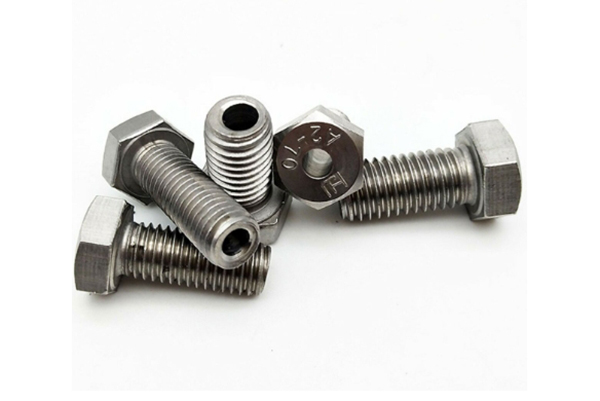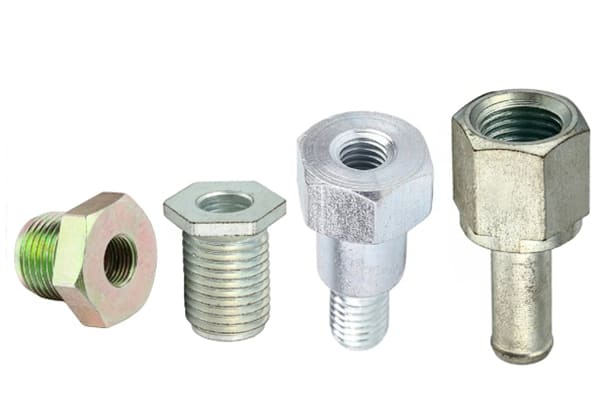Are you looking for a reliable and efficient solution for structural steel connections? This article dives deep into hollow bolts (also known as hollo-bolts), exploring their advantages, applications, and how they compare to other fasteners. You'll learn everything you need to know to make informed decisions about choosing the right bolt for your next project, whether it's in construction, mining, or manufacturing. We'll cover essential topics, from the benefits of using hollow design to the technical aspects of installation and maintenance. This guide is worth reading because it demystifies a critical technology for anyone involved in structural engineering and construction.
1. What are Hollow Bolts and How Do They Work?
A hollow bolt is a type of fastener, often used in structural applications, distinguished by its hollow core. Unlike a solid bolt, the hollow design reduces weight and can offer unique advantages in certain scenarios. The most important thing to remember about a hollow bolt is that the hollow section does not compromise the overall structural strength, which is determined by the high-quality material and precise manufacturing processes. The primary function of a bolt is to provide a secure and reliable connection between two or more components. This bolt achieves this by creating a clamping force, which is the force that holds the pieces together.

In hollow bolts, this clamping force is achieved similarly to solid bolts, but the internal hollow space can accommodate unique features. For instance, they are often used where access is limited, allowing for a secure connection from one side only. This makes them ideal for blind fixing, where the back of the structural member is inaccessible. The way a hollow bolt works depends on its specific design, but the core principle remains the same: to create a robust and dependable connection. This type of bolt is typically made from high-strength alloy steel to withstand significant shear and tensile forces.
2. Why Choose Hollow Bolts over Traditional Bolts?
Choosing the right bolt is crucial for any structural project. While traditional solid bolts have their place, hollow bolts offer several advantages, making them an excellent choice in various situations. One of the primary benefits of a hollow bolt is the ability to create connections in blind applications. Unlike a solid bolt, the hollo-bolts can be installed from one side only. This is essential when access to the back of the structural member is impossible or difficult, which can save time and money. This design is a superior blind fixing solution compared to other fasteners that are more difficult and time-consuming.
Another significant advantage of using hollow designs is a reduced weight. The hollow core removes material, making the bolt lighter without compromising strength. This is particularly useful in structural applications where weight is a critical factor. The hollow design can also allow for the insertion of other components or the passage of utilities through the bolt, adding to its versatility. Furthermore, the installation of hollo-bolts can often be faster and more straightforward than other methods, reducing labor costs and improving project timelines. For these reasons, hollow bolts are increasingly popular in the construction industry.
3. What are the Key Features of a High-Quality Hollow Bolt?
When selecting hollow bolts, it's essential to consider several key features to ensure optimal performance and structural integrity. First and foremost, the material of the bolt should be of the highest quality. High-strength alloy steel is a common choice because it offers exceptional tensile and shear strength, as well as durability. Always look for a bolt that meets or exceeds relevant industry standards, such as those set by ASTM or ISO. The thread quality is another critical factor. The thread must be precisely manufactured to ensure a secure fit and consistent clamping force. Any imperfections in the thread can compromise the bolt's performance and lead to premature failure.

The size and dimensions of the hollow bolt must also be appropriate for the specific application. Using a bolt that is too small or too large can lead to failure. Ensure the bolt is the correct size and length to achieve the required clamping force and provide adequate engagement with the structural members. Look for bolts with a high degree of corrosion resistance, especially if they will be exposed to harsh environments. This can be achieved through galvanization or the use of specific coatings. Finally, consider the head design of the bolt. The head design should be appropriate for the application and should allow for easy installation and removal, if necessary. A well-designed head can also contribute to the overall aesthetically pleasing appearance of the connection. You need the right bolt to connect two steel structural components.
4. How to Properly Install Hollo-Bolts for Optimal Performance?
Proper installation is critical to ensure that hollo-bolts perform as designed, providing a secure and reliable connection. The first step is to ensure that the hollow bolts are of the correct size and type for the application. Verify that the material thickness is within the bolt's specified range. Next, the surfaces of the structural members that will be joined should be clean and free of any debris, rust, or paint that could interfere with the clamping force. The holes must be correctly aligned and of the appropriate size. Any misalignment or improperly sized holes can compromise the bolt’s effectiveness.
Before inserting the bolt, inspect it for any damage or defects. Ensure the thread is clean and undamaged. The bolt is then inserted into the hole, and the nut or other locking mechanism is tightened. It's essential to tighten the bolt to the specified torque, which is the rotational force applied to the bolt during installation. Using the proper torque ensures that the clamping force is within the desired range. The correct torque settings can usually be found on the bolt's specifications or in the project documentation. Over-tightening can damage the bolt or the structural members, while under-tightening can lead to a failure. Always use calibrated torque wrenches to ensure accuracy. After installation, inspect the connection to ensure the bolt is correctly seated and that there is no misalignment. A final inspection should verify that the bolt is providing a secure connection.
5. Where are Hollow Bolts Commonly Used?
Hollow bolts find applications in a wide variety of industries and projects. Their ability to provide strong and reliable connections, even in challenging conditions, makes them a versatile solution. Construction is a major user of hollow bolts. They are used in the fabrication and erection of steelwork, particularly in steel structural connections where access to both sides of the joint is not possible. They are also commonly used in curtain wall systems, bridge construction, and in the assembly of prefabricated structural components. The versatility of the hollow design makes it suitable for a variety of applications.
Mining and tunneling industries also frequently utilize hollow bolts. In these environments, hollow bolts are used for ground support applications, such as securing rock bolts in tunnels and underground mines. The hollow core of the bolt allows for the injection of grout, which further strengthens the connection and provides additional stability. Hollo-bolts are often used in areas with difficult access, making them well-suited for these demanding environments. Another area where you can find hollow bolts is in the manufacturing and industrial sectors. These fasteners are used for securing machinery, equipment, and other components where a strong and reliable connection is required.
6. How do Bolts for structural steel differ based on their design?
Bolts for structural steel come in a variety of designs, each tailored to meet specific structural requirements and installation scenarios. These variations reflect the diverse demands of modern construction and engineering. One of the primary distinctions is the bolt’s head design. Common head types include hex heads, button heads, and countersunk heads. Hex heads offer a reliable grip for standard wrenches, making them ideal for many general applications. Button heads provide a more streamlined and aesthetically pleasing finish, often used when appearance is a consideration. Countersunk heads sit flush with the surface, eliminating any protrusions and are often preferred for safety or aesthetically pleasing reasons. The choice of head depends on the specific requirements of the connection and the desired appearance.
Another critical design feature is the bolt's thread type. The thread determines how the bolt interacts with the nut or the receiving material, influencing its clamping force and shear strength. Coarse threads are typically used for general-purpose applications, offering good resistance to stripping and easier installation. Fine threads provide greater clamping force and are often used in high-stress applications where precision is critical. The choice of thread type depends on the material being connected and the desired performance characteristics. Hollow bolts are often designed with features that enhance their performance and ease of installation. The hollow core allows for lighter designs. For steel structural connections, the design and choice of bolt are critical. This should be a primary consideration in your selection.
7. Blind Bolt Applications: When are they the Best Solution?
Blind bolts are a specific type of hollow bolt that shines when access to only one side of the connection is possible. They are the go-to solution when there is no access to the back of the structural member. This could be due to design constraints, such as a closed box section, or obstructions that make it impossible to reach the back of the connection. The key advantage of a blind bolt is its ability to be installed from a single side, making it ideal for situations where conventional methods would be difficult and time-consuming. This can significantly reduce installation time and labor costs.
These applications are particularly common in curtain wall systems, where steel structural elements are often connected to other components with limited access. Blind bolts are also used in various manufacturing applications, such as the assembly of equipment or machinery where access to the far side is limited. They are often employed in the construction of hollow section steelwork, where the inside of the structural members is inaccessible after fabrication. When considering a blind bolt application, it's essential to evaluate factors such as shear strength, tensile strength, and the desired torque.
8. What are the Advantages of Using Blind Fixings?
Using blind fixings with hollo-bolts offers numerous advantages over conventional fasteners, especially in situations where access is restricted. The most significant benefit is their ease of installation. They can be installed from one side, eliminating the need for access to the back of the structural member. This simplifies installation, reduces labor costs, and accelerates project timelines. This is in stark contrast to conventional methods that would require difficult and often costly access.
Blind fixings provide a clean and aesthetically pleasing finish because the bolt head is flush with the surface. This makes them ideal for applications where appearance is a consideration. They provide a high degree of structural integrity, matching the performance of many other fasteners. They are designed to meet specific shear strength and tensile strength requirements, ensuring a secure connection. They are incredibly versatile. They can be used in a wide range of materials, including steel, aluminium, and composites. Because the hollow bolt can accommodate different designs, blind fixings are suitable for various applications.
9. How to Troubleshoot Common Issues with Hollo-Bolts?
Even with the advantages they offer, hollo-bolts can occasionally encounter issues. Understanding and addressing these problems effectively is crucial for ensuring structural integrity and project success. One common issue is thread stripping, which can occur if the bolt is over-torqued or if the threads are damaged during installation. To prevent this, always use the correct torque settings and inspect the threads before installation. If stripping occurs, the bolt will likely need to be replaced with a larger diameter bolt, or another type of fastener may be more appropriate.
Another issue can be misalignment of the holes. Misalignment can prevent the bolt from seating correctly and may compromise the structural connection. Proper planning and precision drilling of the holes are essential to avoid this issue. If there is a small amount of misalignment, it might be possible to use a tapered pin or ream the holes slightly to accommodate the bolt. If the misalignment is significant, the connection may need to be re-fabricated, or alternative connecting methods, like welded connections, might be required. Another potential concern is corrosion, especially if the bolt is exposed to a harsh environment. Choosing a bolt with adequate corrosion resistance, such as galvanized or coated bolts, is vital. Regularly inspect the bolts for signs of rust or degradation, and replace them as necessary.
10. What are the future trends in bolt technology?
The field of bolt technology is constantly evolving, driven by the demand for improved performance, efficiency, and sustainability. Several trends are shaping the future of fasteners in the construction and manufacturing industries. One notable trend is the increasing use of high-strength materials, such as advanced alloys and composites. These materials offer superior tensile and shear strength, allowing for smaller, lighter bolts that can withstand heavier loads. The advancements in material science are opening up new possibilities.
Another trend is the development of smart bolts. These bolts integrate sensors to monitor torque, stress, and other critical parameters. This data can be used to optimize performance, detect potential failures, and improve safety. Smart bolts represent a significant advancement in condition monitoring. The focus on sustainability is also influencing bolt technology. The design includes developing bolts made from recycled materials or materials with a lower environmental impact. This approach is gaining traction as companies seek to reduce their carbon footprint and meet environmental regulations. The trend towards automation and prefabricated construction methods is also affecting bolt design. This has led to the development of bolts that are easy to install and compatible with automated systems.
Summary:
- Hollow bolts are ideal for structural applications, offering benefits such as weight reduction, access from one side, and a variety of designs to match the requirements.
- High-quality hollo-bolts feature robust material, precise threads, and appropriate size for the application.
- Proper installation, including correct hole preparation and torque, is crucial for optimal performance.
- Hollow bolts are used in construction, mining, and manufacturing, often in situations where access is limited.
- Future trends include the use of high-strength materials, smart bolts, and sustainable designs.
For reliable and high-quality self-drilling anchor systems and drilling tools, contact Allen from China. Explore our range of products that meet the highest standards of performance and safety.
Post time: 2 月-19-2025














